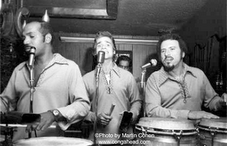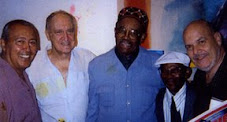In the winter of 1938, shortly after Machito arrived from Cuba, I met the bassist Julio Andino at the Park Plaza ballroom on 110th Street in Harlem. He stood out physically with broad shoulders, like a young Abe Lincoln, gentle-spoken in good English and carefully dressed considering that he was a poor mulatto. It was during the Great Depression and while the rest of New York was emerging, Harlem was still deep in despair. The Park Plaza was a refuge from the sadness of the time, offering melodies and memories of the islands that the locals had left behind but not forgotten. He had not come to the Park Plaza to dance but to listen and learn from the Happy Boys, the house band, with Doroteo Santiago singing. Pagani, the leader, invited Julio to sit in, as Noro Morales used to do with the then young Tito Puente.
When I spoke to Julio we saw that we shared a similar ambition, namely, to bring Latin music from Harlem to Broadway. But to come down the three short miles from 110th Street to 52nd Street meant conquering more than distance. An invisible shield kept the two worlds apart. Julio idealized a cultural crossover employing the magic of music as the means. He had ventured downtown and could foresee working beyond the confines of the black community where employment might be found. In doing so, his overlooked contribution was to become the uniting and strengthening of cultural/musical interests in the Anglo/Latino world. Without Julio’s vision and ambition for self and society’s betterment, Latin music might still be restricted to niches, jibaros and campesinos rather than the universal music it has become.
Cuba became a true nation when the Spanish military bands of Santiago blended with the Afro-influenced rumbas of the sophisticated nineteenth century Havana, a crossover opposed by aristocratic gentry of the time. This resembled the union of the West and East coasts thanks to the railroad that made us a proper nation. Julio’s ambitious dream was to hitch his music to the American dream, joining two worlds like Columbus. He had inherited a disrespectful musical world, one in which the phenomenal “Peanut Vendor” was to be a fluke, a melodic freak. He championed a lost cause, all the while knowing that buried treasure existed in the souls of all nations, waiting to manifest itself. “La rumba no hay frontera.” His dream was not primarily to lead an orchestra like Cachao and Oscar D’León, bass players, but to bring cultures in synchronization, not to join the country club of the pantheon of Puerto Rican all-stars for self-glorification, but to benefit all people; like an outcast prophet, he labored unrewarded, insufficiently acknowledged, where even Nicola Tesla and the scientist Fleming eventually received their high honors. He died leading his orchestra when actually it was the whole world he wanted to see, bounded in harmony, as Tito Puente has since done.
At the Park Plaza, the dance floor resembled a rush hour A train, except that the dancers were not stepping on toes. They were the very best dancers in that winter of 1938–39. Rene and Estela had just ended the routine that they had performed in Hollywood’s Thin Man movie, this time for the enjoyment of Lo Nuestro.
The dancers Electrico, Midnight and Chino (even a mulata was dancing on crutches) were competing during continuous applause—nonstop encouragement. The sweet scent of the tobacco of the tropics came up from the basement lounges, blending with the cologne in vogue, called Tabu. Most of the dancers were from the area around 116th Street (the main street before 125th Street became known as such) and from 114th Street, the most dangerous street in Harlem, perhaps in the whole city. They were frenetic but with wholesome Latin exuberance under the spell of a band that brought them “home,” to the islands of their enchantment, unlike the latter day sick Studio 54 that set dancers adrift, lost somewhere “far out” in space. The young girls, so shapely in their homemade, well-fitted dresses; the sharp guys with their black and white shoes, the mark of an accomplished rumbero. Slickened hair managed to overcome the huge overhead fans that were intended to cool off overheated dancers. In a musical orgy, like a feeding frenzy in a steam bath, they possessed the stamina of prizefighters. When the seemingly inexhaustible band gave signs of taking a break, the dancers were seen to prostrate themselves, pounding their fists in mock protest! Using silence as a clever device, the beat continued pounding there, like claves. All this punishing trickery would be skillfully and mercifully ended by the piano ever so casually, softly resuming the melody followed by the full band, released like wild horses. (During four days of Carnival in Rio, samba is nonstop.) Some dancers fell to their knees, pleading and supplicating the exhausted band. The entire company, dancers and musicians, ended in a joyful victory that defeated the gloom of the world outside.
There was no set closing time. It ended when the last couple went for their coats. Once outside, they crossed the street into Central Park to play out their deep arousals. The rowboats lining the lake soon served to cradle the partners under a cold grey sky. Here, far from palm trees, they shared mankind’s most heavenly encore. For the few who walked home alone, they could still hear Doroteo singing “Tu no comprendes” like a surrogate lover. Quite soon, they were in the arms of Morfeo. Tomorrow, Sunday, there would be another dance, bigger and better.
This then was the scene at the Park Plaza, where Doroteo’s untrained voice would sprinkle lyrical kisses over the heads of the dancers who sang along with him. Like an angelical conspiracy, it evoked a sweet tenderness that replaced the hopelessness of 1938 Harlem. Julio spoke with me during breaks. I couldn’t speak the language and couldn’t dance or play an instrument; still he viewed me as a way to help him defeat the dark pit of Harlem. Was he mad like most visionaries? To attempt to bring this Latin phenomenon to the lights of Broadway—into the big time in the Big Town!
“Forming the orchestra would be simple,” he said. There was an overabundance of unemployed talent. Placing a non-union band in “off limits” territory only needed some show-biz luck and a San Lazaro—or St. Jude.
First we needed a group photo to show us as already existing, at least on paper. Julio picked up a pianist (perhaps it was Ruben Berrios), two brothers playing great guitarras, and a young kid named José Mangual. I was to be the clavero, campanero, maraquero and manager.
Placing the “band” became the problem. I brazenly called the Major Bowes Original Amateur Hour located in today’s Ed Sullivan Theater, where several music publishing businesses had offices, including Sunshine Music Publishing Company that printed sheet music in Spanish and English.
A date for an audition was set. Minus our bongocero, José Mangual, most unfortunately, and inadequately rehearsed, this band with no name that resembled some hungry subway musicians, set up in the radio studio. With two songs only heard in Harlem, featured in the Cancionero Picot (a songbook distributed to bodega customers free of charge), we began. Toward the end of “Letrago,” we went into the montuno. The two judges mistook this totally unfamiliar change of tempo to be some sort of sloppy befuddlement on the part of the band. When we encored with “Tabu,” we realized we'd failed, but at least we had “played on Broadway”!
We left the studio defeated, but upbeat. The bright lights of Broadway in ’38 hardly reached up from 42nd Street to where we were on 53rd. Julio suggested a drink, not in celebration but rather to cheer things up. He mentioned the Half Moon on 81st off Broadway. Walking over a mile in thin clothing was impossible with the instruments. We entered the five-cent subway at 50th Street, where on a bench we found a pocketbook with fourteen dollars! Dividing this small fortune, we began to understand the whimsicality and capriciousness of show biz.
...to be continued
 One matinee at La Conga, a short, good-looking 17-year-old was seen cutting his way through the tables. He was carrying something half hidden on his way to the rear of the bandstand. He did this without disturbing the moment, which happened to be a romantic “precioso bolero.” No doubt he had come, not to sit in with the band, but to practice his bongos with Noro’s approval. He sat off the bandstand in a corner. It was the first time I heard someone say, “Tito Puente.”
One matinee at La Conga, a short, good-looking 17-year-old was seen cutting his way through the tables. He was carrying something half hidden on his way to the rear of the bandstand. He did this without disturbing the moment, which happened to be a romantic “precioso bolero.” No doubt he had come, not to sit in with the band, but to practice his bongos with Noro’s approval. He sat off the bandstand in a corner. It was the first time I heard someone say, “Tito Puente.” 






